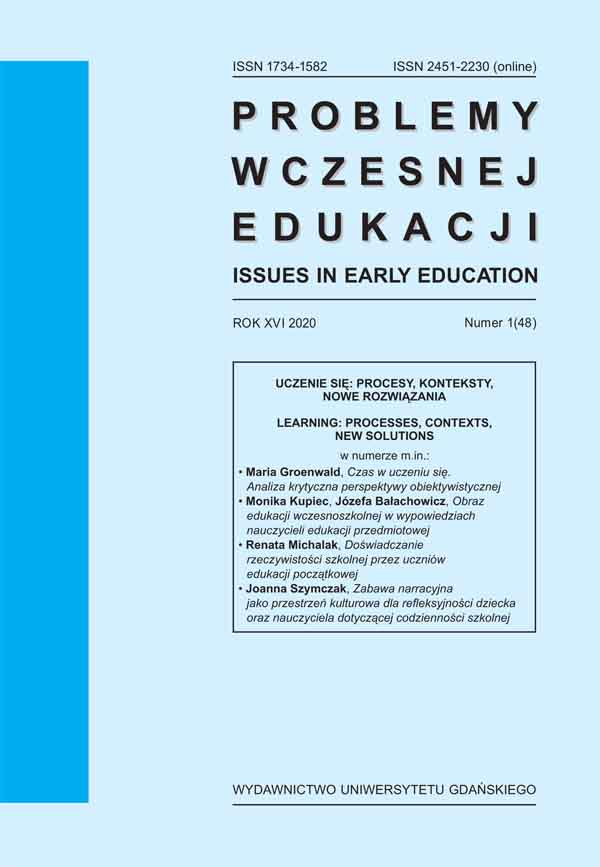O nieprzedstawieniach i twórczości. Raport z wstępnych badań nad abstrakcją w aktualizowaniu i stymulowaniu twórczego myślenia u dzieci w wieku wczesnoszkolnym
DOI:
https://doi.org/10.26881/pwe.2020.48.08Słowa kluczowe:
zajęcia artystyczne, abstrakcja, twórcze myślenie, dzieci w wieku wczesnoszkolnymAbstrakt
This article is a report on the planned and conducted series of experimental art classes dedicated to children in early school age. The aim of the presented initial research was the verification of a working hypothesis assuming the positive influence of a planned and conducted art lesson class cycle inspired by abstraction, on the creative potential of the participants. In the research project presented and described below, abstraction has been treated as a potential factor stimulating creative thinking, the level of which has been identified by using Drawing Creative Thinking Test by K.K. Urban and H.G. Jellen (TCT-DP) in pre and post-experimental version. The research project was implemented on the basis of a quasi-experimental method, however – which must be emphasized – it has been based on the assumptions of action research and constructed on the basis of the ARTography category. 64 students from the first grade and two second grades of a primary school participated in the experimental class cycle. 47 pairs of drawings created on the basis of TCP-DP sheets have been analyzed and assessed. As a consequence, the distinguished working hypothesis has been initially confirmed – however, the presented research field requires further research, exploration and detailed analyses. The presented research and its initial results constitute a factor initiating the considerations regarding the possibility of applying and implementing non-standard solutions in art lessons, which – as it turns out, end up being solutions that are enriching and desirable, especially from the creative thinking perspective.
Downloads
Bibliografia
Adler P. (1977), Beyond Cultural Identity: Reflections on Multiculturalism. W: R. Brislin (red.), Culture Learning. Honolulu, Hawaii University East West Center Press.
Arnheim R. (2011), Myślenie wzrokowe. Gdańsk, słowo/obraz terytoria.
Aronson E., Wilson T.D., Akert R.M. (1997), Psychologia społeczna. Serce i umysł. Poznań, Wy-dawnictwo Zysk i S-ka.
Bator M. (2014), Ekspresjonistyczny horyzont abstrakcjonizmu. „Dyskurs: Pismo Naukowo-Artystyczne ASP we Wrocławiu”, 18.
Bauman T., Pilch T. (2001), Zasady badań pedagogicznych. Strategie ilościowe i jakościowe. Warszawa, Wydawnictwo Akademickie „Żak”.
Berleant A. (2010), Wrażliwość: wzrost pewnej estetyki. „Sztuka i Filozofia”, 37.Burns A. (2015), Action research. W: J.D. Brown, C. Coombe (eds.), The Cambridge Guide to Research in Language Teaching and Learning. Cambridge, Cambridge University Press.
Çeken B., Çelik G. (2016), The Reflection of Geometric Forms to Abstractions in Turkish Art of Painting. „IOSR Journal Of Humanities And Social Science”, 21(10).
Czyżewski S. (2014), Eseistyczne meandry wokół abstrakcji. „Dyskurs: Pismo Naukowo-Artystyczne ASP we Wrocławiu”, 18.
Drabek M. (2018), Dominacja wzroku. Kryzys pisma po zwrocie wizualnym. „Kultura – Historia – Globalizacja”, 8(23).
Drohomirecki A. (2014), Wzniosła bezprzedmiotowość. Abstrakcja w malarstwie Paula Cézanne’a. „Dyskurs: Pismo Naukowo-Artystyczne ASP we Wrocławiu”, 18.
Goodman N. (1997), Jak tworzymy świat. Warszawa, Fundacja Aletheia.
Leavy P. (2018), Metoda spotyka sztukę. Praktyki badawcze oparte na sztuce. Warszawa, Narodowe Centrum Kultury.
Matczak A., Jaworowska A., Stanczak J. (2000), Rysunkowy Test Twórczego Myślenia K.K. Urbana i H.G. Jellena. Podręcznik. Warszawa, Pracowania Testów Psychologicznych Polskiego Towarzystwa Psychologicznego.
Mesquida P., Inocêncio K.C.M. (2016), Art and Education or Education through Art: Educating through Image. „Creative Education”, 7(09).
Możdżyński P. (2011), Inicjacje i transgresje. Antystrukturalność sztuki XX i XXI wieku w oczach socjologa. Warszawa, Wydawnictwa Uniwersytetu Warszawskiego.
Nietzsche F. (2006), Narodziny tragedii czyli hellenizm i pesymizm. Kraków, Wydawnictwo Zielona Sowa.
Read H. (1958), Education trough Art. London, Faber and Faber. https://archive.org/details/in.ernet.dli.2015.460970, 17.07.2019.
Rudomino T. (1990), Mały leksykon sztuki współczesnej. Warszawa, Wydawnictwo Collage. Słownik terminów artystycznych i architektonicznych (2011). Warszawa, Wydawnictwo Agora.
Śmiechowska A. (2010), Mistrzowie sztuki nowoczesnej. Jackson Pollock. Warszawa, Add Media.United Nations Educational, Scientific and Cultural Organization(2006), Road Map for Arts Education The World Conference on Arts Education: Building Creative Capacities for the 21st Cen-tury Lisbon, 6–9 March 2006. http://www.unesco.org/new/fileadmin/MULTIMEDIA/HQ/CLT/CLT/pdf/Arts_Edu_RoadMap_en.pdf, 12.07.2019.
Zusak M. (2019), Złodziejka książek. Warszawa, Nasza Księgarnia.

 Uniwersyteckie Czasopisma Naukowe
Uniwersyteckie Czasopisma Naukowe





